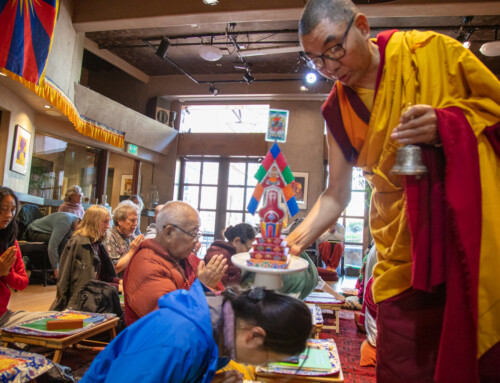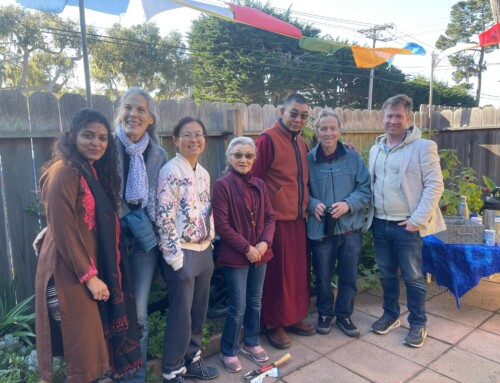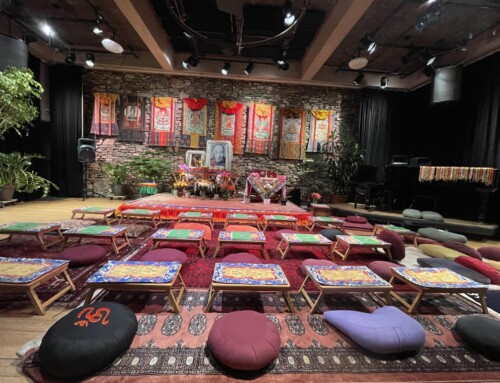In this blog, I would like to speak a bit about technology and social media.
Until I travelled outside of Tibet, most of my life I had little exposure to modern technology. I spent my earlier years in the Kham region of Eastern Tibet. Life in the remote villages of Tibet was very simple and pure, and villagers’ way of living was quite spartan, but truly people were happy and content. Modern conveniences and facilities were unheard in those days, not to speak of modern technologies. To illustrate, it wasn’t until 1997 that I first used a phone.
During this time, I was forced to flee in secret to the capital of Tibet, Lhasa. None of my family knew of my whereabouts, so in order to inform them, I had to seek out a telephone. In those days, there was a sort of public phone in downtown Lhasa; so many people were waiting to use this one telephone, and the line was 4 hours long. At the end of the line sat a telephone operator stationed in a small booth with the telephone next to her. People would pay to use the phone, and because so many people were oblivious to the workings of a phone, she would assist users and instruct them on how to place calls and generally how the phone worked. When I reached the end of the line and it was my turn, I didn’t know how to dial and even placed the phone incorrectly against my face. She then took the phone and reoriented it, explaining to me how to place a call. My family did not have a phone, so I had to call my aunt’s neighbor who was one of the only people in the village who possessed a phone. Even though she was my aunt’s neighbor, their homes were still around 10 minutes walking distance apart. When they answered, I explained who I was and requested that they retrieve my aunt. They were very happy to help and immediately went to call my aunt. In the meantime, I had to wait and the person next in line made their phone call. When it was again my turn, I called back a second time, and upon calling I was able to connect with my aunt. I lost my mother when I was only 3 months old, and my aunt took care of me like a mother during my parents absence. Because of this, I used to call her “mom”. She said to me, crying, “My son, are you alright? Where are you?”. I told her, “Yes mom, I am doing well. I am in Lhasa now. I have visited many monasteries and have seen many nice things, and have been pursuing Dharma-related activities. Please don’t worry, I am ok.” She didn’t know but eventually I escaped to India without anyone else knowing. In 1999, while in Dharamshala in India, some Tibetans asked me whether I had an email. I responded that I didn’t know what an email was. My friend then told me, “You need it; I will help to make one.” India was more technologically advanced than what I had experienced in Tibet, and eventually I made my way to Malaysia, which was even more developed.
In 2003 while I was living in Malaysia, my students took me to visit the city of Kuala Lumpur. We saw many skyscrapers and modern buildings. Everything was so clean and beautiful. As I was gazing into one of the shopping windows, a student of mine asked me, “Rinpoche, do you have a cell phone?” I did not own a cellphone, and even if I had wanted to, I did not have the money to purchase one. She said, “Many of our Teachers now have cell phones, and we are able to contact them. You also should have one.” I responded, “Oh no, thank you; I don’t need it.” She then told me, “No Rinpoche, I need to call you, this way if you have the phone I can call you anytime.” She purchased a small Nokia cellular phone for me. At that time, this phone was quite advanced and very popular. When I showed my fellow monks my new phone, they were all saying, “Wow, this is a really good one, Khenpo.”
In 2009, when I visited my Sangha in Boston, one of my students, an American, asked me whether I had a Facebook. At the time, I had no idea what Facebook was, nor had I even heard of the name Facebook. Actually, in my mind, I tried to translate the word into Tibetan and separated it into two words “face” (donh), and “book” (dheb); this did not make any sense to me. My student then said to me, “Rinpoche, you should have Facebook because right now, you are living in the United States. Everyone has a Facebook. Moreover, most of your students and friends are based in Asia. They would love to see and to hear from you and know your where you are.”
I responded to my student’s request, saying, “That’s a very good idea, please help me right now!” My student then set up an account for me. When I first opened Facebook, I didn’t use my name; instead, I created a profile for the Manjushri Dharma Centre. My student showed me how the platform was set up, how to navigate the web page, and how to post things. I completed my profile by filling in information, adding some photographs, and writing a few messages. Amazingly, very quickly I discovered that people from many different places were able to find me. Students from Asia wrote to me saying that they were so happy to see me on Facebook. Many told me, “We haven’t heard from you in over 10 years and thought that we had lost you!” It made me feel very happy to hear from them.
Once I discovered how Facebook worked, I thought to myself, although I’ve lost my country, I would love to connect with those still in Tibet. I wished to see my brother and I hoped to reach my Dharma brother monks, other family members and friends, and I wanted to see photographs of my beloved homeland and my old monastery. I inquired, why don’t Tibetans have social media? I did not know that the Chinese government blocks these websites, including other social media like Facebook, Twitter, etc., and google products like YoutTube in China and Tibet. This is very unfortunate and made me quite sad; the internet is like a bridge or road which connects people, and in this case I was unable to make this connection with those dear to me.
Since 2009, I have used technology, the internet, and social media a lot because, as a Dharma teacher, I have a commitment to all of my students and friends from around the world. We have a connection with one another, and I want to maintain my closeness and relationship with them.
Given the way that social media, such as Facebook, Youtube, Twitter, Instagram, etc., is viewed in society, occasionally a few of my students are taken aback when they learn that I, a renunciate who has taken vows, have an account on social media. They often say to me, in a surprised manner, “Oh Khenpo, you also have Facebook? Oh no… I don’t even have a Facebook page; I don’t like social media. Humph!” I find it very humorous when I receive this feedback. Of course, they may think that social media is definitely and completely a bad thing. I think that this is a wrong view. I tell my students, “Yes, of course I use social media. In actuality, my social media is an extension of my Dharma Centre.”
Nowadays, so many people have joined social media; currently, there are almost 2.5 billion active users on Facebook alone. I myself have many connections and friends on the site, and so many have found me through the Dharma Centre webpage, my blog, social media, email, etc., and they use technology as a way to stay connected with me. My blog has been a way to disseminate my teachings online to people from many different countries. To date, my blog has been viewed almost 75,000 times; almost half come from the United States, and many read from Russia, Bhutan, Malaysia, Nepal, Singapore, Germany, and Taiwan. There are also three Tibetan Lamas from Switzerland, Canada, and Minnesota who told me that they really like the teachings and check the blog every week. In addition to the blog, the main Manjushri Dharma Centre website has general information, events and class schedule, various teachings, contact information, etc., and on YouTube one can find videos of my live teachings and songs among other things. Actually, some of my students have told me that, although they previously did not have social media, they created an account to stay in contact with me, to watch live streaming from the Dharma Center, and to see and hear updates on what I am doing, etc., and others tell me that they really enjoy what I post, such as my teachings, photographs, and videos.
Because of the current pandemic, places of worship are closed throughout California; consequently, all in-person activities have been suspended at the Manjushri Dharma Centre in Pacific Grove. Fortunately, in this situation, technology has permitted the continuation of activities and the practice of holy Dharma during the lockdown. For example, we have held Facebook live streaming of Green Tara and Red Avalokiteshvara practices in the past few months. Additionally, since the onset of COVID-19, we have conducted chanted prayers of Medicine Buddha Monday nights via Zoom meetings for all those suffering, especially from illness and death. We have also conducted Guru Rinpoche (Padmasambhava) sadhana practice Trinley Nyingpo, The Essence of Enlightened Activity, via Zoom.
Through Zoom, we practice for one hour and are able to see one another, pray together, and even share Dharma texts. In many ways, Zoom really has become our Dharma Centre. In addition, because we are cautioned not to meet, technologies such as email and phones allow us to stay in contact with one another. Some students, including those who live far away, may not have access to local Dharma Centres or may not be able to see Dharma teachers. In this way, technology can help those who need it. This is especially true today; these various technologies allow us to safely maintain distance to limit the spread of this disease and in doing so we are able to follow government guidelines. Two of my Singaporean students have told me that during this time there are many more Dharma activities going on than before and so many Lamas are conducting teachings through technology. Instead of being stuck in their office, they are staying home where they can practice and listen to many different teachers. This use of technology, for the benefit of all sentient beings and the practice of holy Dharma, is certainly a good thing!
I also want to mention an important point. Right now we live in the information age of the 21st century which has been marked by advances in science and technology. It is arguable that to live today, we must rely on and use some form of modern technology. That being said, how technology is used, however, is completely dependent on the person. These examples of technology that I gave, such as social media, can be good for human beings, but it entirely depends on who is using these things. Benevolent people, such as His Holiness the Dalai Lama, use these technologies, such as social media, in order to benefit all sentient beings. For instance, HH graciously gave a two-day teaching on Master Nagarjuna’s “Precious Garland” through his website during the pandemic, all together, around 900,000 watched. Technology permits many more people to listen to these precious teachings; having this many people in one space physically would be extremely difficult and without technology this could not be done easily.
It is therefore not the technology that is in itself bad; it depends on the person and we have the choice how to use technology either to harm or to help. It is entirely dependent on you and it is in your hands how to use these things and for what purpose. This is true even with simpler things, like fire, which can be used in positive ways like cooking food, but can also be very dangerous and can burn down one’s home.
We should be careful, for instance, with young children whose minds are not fully developed. Things such as video games and cellphones can negatively impact their young mind, especially those which are violent. It is certainly not good when someone uses technology with bad intentions for negative ends or to harm. Instead of hurting others, we should use technology in the best way possible to help other sentient beings. Therefore, use your mind, knowledge, and right understanding to use technology in the best possible way.
In the 21st century, we live with technology, which has become truly ingrained and a part of our life. Even though some of us may not like this fact, it is a fact that we cannot easily escape; we cannot just throw all of these things away. Some express a wish to return to more austere times; as a Tibetan, my mind naturally goes back to the 7th, 8th, and 9th century in Tibet. Even in relatively recent times, life there was very different and people lived without what we consider basic comforts and facilities. Nevertheless, this made for a very simple, fulfilling and happy life, but that was a different century. They lived in a very different way, but we cannot live in the past and we cannot escape the present moment. We must live in the now and recognize our relationship with technology. Let’s say that you want to live peacefully in a home, just like a family; if you live with your parents, spouse, children, partners, etc., if there is a family member who is not agreeable or whom you do not like, what should you do? Do you want to fight with them everyday? This is not a good idea and will not solve anything. Accept them; be nice; live together; and help each other. The same holds true for technology; we didn’t choose our family, nor did we choose the time period in which we are born. Still you lived together with your family. Just like family, we currently live together with technology. We must use these things even if you don’t like it, you should accept them and use them in a positive way.
~Khenpo Karten Rinpoche
I, Khenpo Karten Rinpoche, dictated this blog in English, my second language, which was subsequently transcribed by my student, Karma Choeying, over the span of a few days in May in order to demonstrate the benefits of technology and how to live technology in our the current age. Tashi Delek






